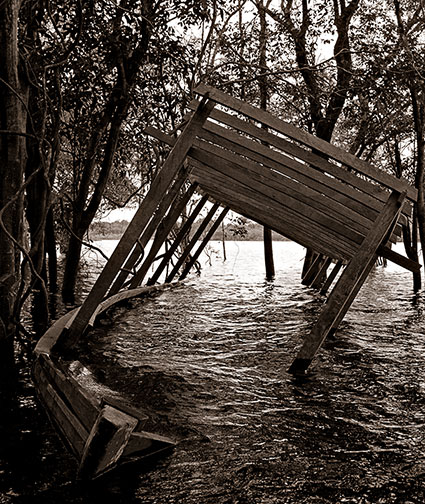
Sunken Dreams. Amazonia, Brazil. April, 2007
Leica M8 with 28mm f/2.8 Elmarit-M ASPH @ ISO 160
After every major expedition or field shoot I write up a small piece onWhat Worked, and What Didn’t. This includes photographic equipment as well as non-photographic gear, facilities and other arrangements.
My April 2007Amazon Expedition Workshopsaw 16 photographers and spouses spend 11 days on a riverboat on the Amazon and its tributaries. Temperatures were 30C+ (85F+) with 80%+ humidity every day. We had every combination of rain, cloud, sun and fog that one can imagine. On at least one day while we were out in the canoes we had torrential rain which lasted for hours.
Other photographs from this shoot, along with descriptions and anecdotes
can be found onthis page.
____________________________________________________________________________________
The Challenges
The challenges faced on this trip included travel logistics, weather, humidity and rain.
Flying
As is the case everywhere these days, travel with large quantities of photographic equipment is a hassle. Since 9/11 things have become even tougher, and also more confusing, as the airlines are constantly changing the rules and are very inconsistent in enforcing them.
For example, TAM, the Brazilian airline which most of us used to fly from Miami to Manaus, Brazil clearly states on their web site that carryon bags are limited to 5kg, the lowest of just about any airline, and half that of many. The reality is that the rule is totally unenforced (it least it was on our flights). Of course ones carry-ons still have to be able to fit in the overhead compartment.
For the past few shooting trips that I’ve made I have been using theThinkTank Airport Internationalbag. This is a brilliant design for travel, though not very good for shooting once on location. For this reason I pack all of my chargers, batteries, cables and such in a small day pack (currently my preference is theLowepro Slingshot 100) and then put this in my checked duffle bag along with my clothes. Once on location I remove all of the bits and pieces and load the cameras and lenses that I need for the day in the Slingshot.
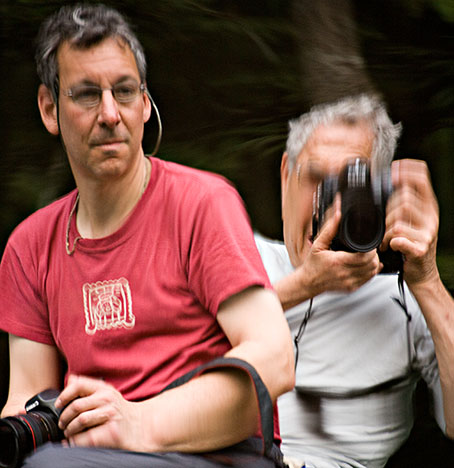
On Reflection. Amazonia, Brazil. April, 2007
Canon 1Ds MKII with 100-400mm L IS lens @ ISO 640
Workshop instructors Andrew Rodney and Jay Maisel seen in reflection in the black waters of the Rio Negro
Humidity
The high humidity found in the Amazon jungle isn’t that big an issue for equipment in and of itself – at least not for the relatively brief two weeks that we were in country. (It can be an issue when equipment is used in such climate long-term). The real problem comes when equipment is brought out of air conditioned rooms.
Our cabins were air conditioned at night, and so I recommenced that everyone leave their camera gear in the ship’s dining room, on a side table. That way there would be no condensation problems. This worked very well, but occasionally when someone took a camera or lens that had been in the cabin overnight out for a shoot, it could take as long as a half hour for the front element to clear. It’s also not unknown for cameras to short-out from internal condensation. Fortunately none of us had this experience.
In fact, this was one of the most trouble-free shoot trips I’ve seen in a while. There wasn’t a single equipment failure among us.
Rain
After the experience which my group had inAntarctica in February, I made sure to advise everyone on this trip to bring rain protection for not only themselves but their camera gear as well. A good quality poncho works best because it is the coolest covering in hot weather, and it allows for quick and easy protection of most gear.
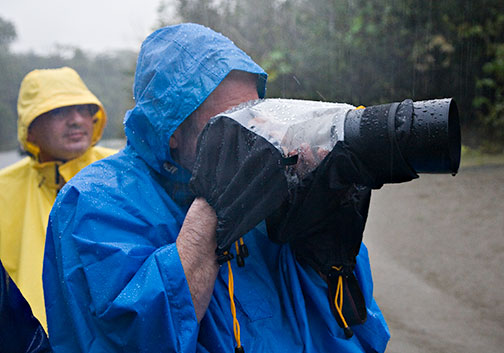
Photograph by Andrew Rodney
I had also recommended theKata GDC Elements Cover 702, and many of the shoot’s members used these with great success. I’ve used a number of different rain covers over the years and this is without a doubt the best one yet. It has draw-strings on the sleeves and a transparent top which allows for fumble-free camera settings. The bottom of the bag seals with a large zipper. All-in-all a must-have for any outdoor photographer.
____________________________________________________________________________________
In The Bag
Of the dozen photographers on the trip, seven used Canon gear, four used Nikon, and one used a Sony A100. I brought my Canon 1Ds MKII with a Canon 100-400mm f/5.6 L IS lens. This turned out, as I expected it would, to be my most used camera / lens combination, accounting for probably 75% of the more than 6,000 frames that I shot.
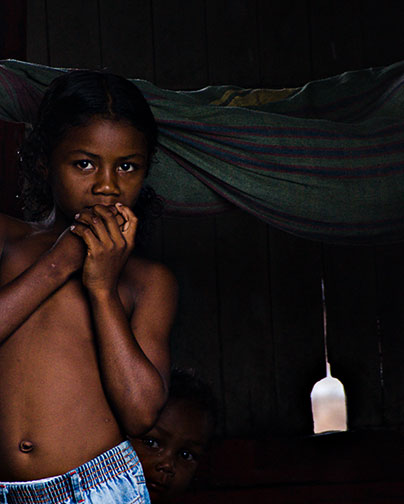
Shy Peeks. Amazonia, Brazil. April, 2007
Canon 1Ds MKII with 100-400mm L IS lens @ ISO 400
I had hoped to have a pre-production Canon 1D MKIII for testing on this trip but it failed to arrive in time for my departure. (It did show up by the time I returned two weeks later, and I am currently (late April) working on my initial hands-on report on this exciting new camera).
Another no-show was the Phase One P45+. I had hoped to have it in Hasselblad mount before departure, but it too didn’t arrive in time. I brought my H2 and P45 with a few lenses, but ended up not using them too much as the Canon with its long lens and high speed (high ISO as well as fast frame rates) proved to be more versatile for this trip’s shooting.
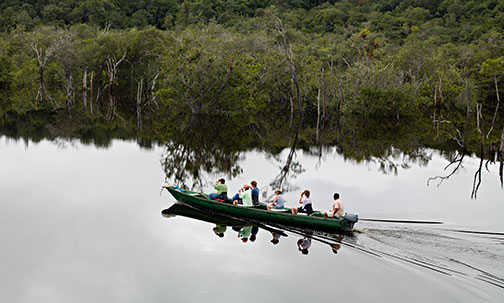
I also brought my Leica M8 with the 28mm f/2.8 Elmarit and the new wide angle Tri-Elmar. This worked out very well for the street shooting we did in towns and villages, and also for wide angle work in the jungle and from the canoes.
Just before leaving I downloaded the latest M8 firmware and found that the biggest improvement was in the auto white balance. It now is highly consistent and spot-on much of the time. My biggest complaint with the M8 remains with the wake-up from sleep mode. It simply is too long for a contemporary camera. Other digital cameras are now almost instantaneous. Why the M8 has to take several seconds is beyond me. More than one shot was missed on this trip as a consequence.
The solution of course is to turn off sleep mode, but then the battery runs down quicker than it should. Come on Leica – fix this soon please!
Otherwise I couldn’t be more happy with the performance of the M8 on this shoot. (I didn’t use the IR lens filters because since there was no one wearing artificial fabrics in my shots, they were unnecessary). The M8’s added IR sensitivity in fact proved advantageous when shooting foliage and then doing B&W conversions.
I broughtBetter Beamersfor everyone, and though we used them a few times, there wasn’t as much wildlife as we had hoped, and so these didn’t see as much use as anticipated.
Olympus 770 SW

Just before I left on the trip I received anOlympus Stylus 770 SWfor testing. I don’t usually review digicams, but often travel with one, and when I think there might be an opportunity for some water play I bring one that’s waterproof. (In the past an APS film-based Canon ELF Sport).
The 770 is a wonderful little camera. Looking hardly different than any 7MP pocket digicam this little Oly is a stand-out because it is claimed to be Shockproof, Waterproof, Freezeproof, and Crushproof. You can drop it onto the floor from a height of five feet, take it snorkeling to a depth of 33 ft, and use it to -10C, all without an accessory waterproof case.
When I first got the camera I enjoyed shocking people by dropping it into a glass of beer or my soup, but it turned out to be much more fun when we were swimming in the Rio Negro. (Swimming in the Amazon is a bad idea unless you like Piranhas nibbling on your toes. It’s also very muddy).
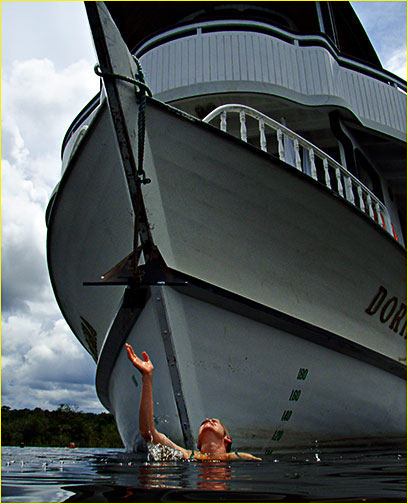
Fiona Rising. Rio Negro. Brazil
Olympus 770 SW
Fiona Reid, our trip’s naturalist, attempts to grab the ship’s anchor
during a mid-day swim in the Rio Negro.
This is a wonderful little digicam that can go with you anywhere – literally. Ifyoucan take it, the 770 can take it. I really have only two complaints. The first is the use of Xd cards. I wish Olympus would wake up to the fact that this is a dead end. There really is no need for yet another small memory card standard when SD does the job.
The other problem is that the provided wrist strap doesn’t have a tightening loop, and since the camera doesn’t float, if you are using it in the water there is a real risk of it disappearing into the depths never to be seen again.
Otherwise – fine image quality, great built quality, and good value. Recommended.

Self Portrait. Rio Negro, Brazil. April, 2007
Olympus 770 SW
This somewhat unflattering underwater self portrait was done using the camera’s built-in flash
and with the camera set to one of its special underwater shooting modes used for close ups.
____________________________________________________________________________________
Computers and Storage
People had different approaches to storage on this trip. Some just brought enough memory cards for the whole trip, but most had laptops and outboard hard drives. I brought my 13" Macbook and two external firewire drives, the 160GBSmartdisk Firelights. I would daisy chain these drives and then set Lightroom to import from my cards to both drives simultaneously, thus creating an instant backup.
I would then store the drives separately, and when traveling home at the end of the trip I put one drive in my carry-on bag and the other in my vest pocket. Remember, it’s not a question ofwhethera hard disk will ever fail, it’s only a question ofwhen. Also, the possibility of accidental damage, theft or other form of loss makes having a backup of ones files a must. I can imagine losing or having stolen my camera gear, or even my wallet or passport. Hassles and expensive – yes, but recoverable from. Not so if all ones images from a once in a lifetime trip like this are lost.
Having a small ship as a shooting venue is ideal in a workshop environment. I’ve done this in China, Antarctica, and Bangladesh and each time have found it to work very well. The reason is that after each shore excursion one can come back, copy cards to the laptop and have instant feedback as to what one is doing. In a group environment this also means the ability to share ones work and discuss both technical and esthetic issues relating to what one had just done in the comfort of the ship’s lounge.
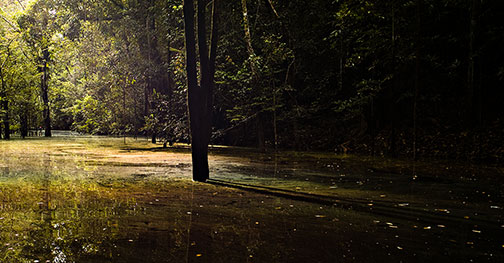
River Dawn. Amazonia, Brazil. April, 2007
Leica M8 with 28mm f/2.8 Elmarit-M ASPH @ ISO 160
A dawn canoe ride though one of the Amazon’s tributaries. The river was like a mirror
reflecting the light of sunrise, contrasting with the deep forest gloom.
____________________________________________________________________________________
Amazonia Expedition

Our workshop was aboard theDorinah, a ship operated byAmazonia Expedition. The founder of this company and captain of our ship on this trip was Mo Pereira. Mo is a charismatic individual with more than 30 years experience as an Amazon river pilot. In addition to Portuguese, Mo speaks excellent Spanish, English and German, and can tell hilarious stories in all of them.
I have nothing but praise for Mo, his ship (one of several that he operates) and his crew. His knowledge of the river system as well as its flora and fauna are encyclopedic. He also is highly customer focused, trying to give his passengers what they’re looking for, be it wildlife, landscape or local culture.
If you’re thinking of a trip to the Amazon I can highly recommendAmazonia Expedition.

The 2007 Amazon Expedition Group
Other photographs from this shoot, along with descriptions and anecdotes
can be found onthis page.
____________________________________________________________________________________
Andrew Rodney,The Digital Dog, and one of the instructors on our Amazon Expedition,
has published slide shows of both hisfun stuffandmore serious photographsfrom the trip.
____________________________________________________________________________________
You May Also Enjoy...
Epson Stylus Pro 5500 Review
Epson Stylus Pro 5500 See below for a personal update on my experience with the 5500. Bigger, Faster Stronger A Review by Cris Daniels
Oct 2001
Critique Submissions This page contains selected October 2001 submissions from photographers who wished to have their photographs reviewed by the publisher of this site,Michael Reichmann,
